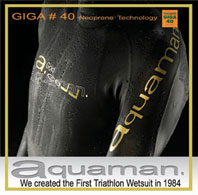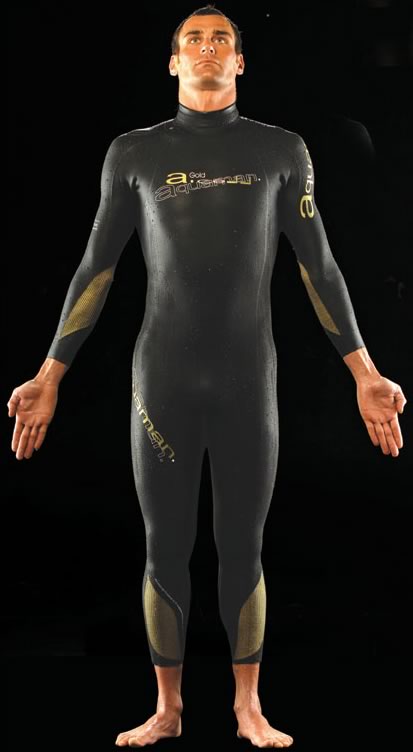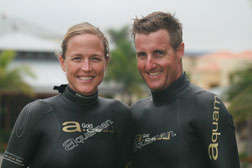Black Gold: Aquaman’s CellGold Wetsuit

Aquaman has been making triathlon wetsuits for a long time. A very long time. According to them, Aquaman made the very first triathlon wetsuit back in 1984. Now our esteemed publisher may have his own version of who exactly made the first triathlon wetsuit, but he's not writing this review. Regardless, Aquaman has been making wetsuits for triathletes since before most triathletes probably even knew they wanted one.
Over that time, Aquaman has zigged where a lot of other companies have zagged, and zagged where a lot of other companies have zigged. An Aquaman suit has a few features that are uniquely theirs (or at least were for a long time, though others are starting to adopt some of them), and many Aquaman users won't ever swim in any other suit for wont of being able to find these particular features. We'll get into those features more later, but I bring this up because wetsuits are a very particular thing. It's something that fits skintight, yet miraculously, due to the wondrous nature of neoprene, two very different people can often find happiness in the same suit. Of course, they can also find happiness in very different suits. So, bearing in mind that wetsuits are such an individual thing, and that Aquaman takes some very individual stances on how a wetsuit ought to be made, the purpose of this review is not necessarily to urge you to buy this particular suit (or to not buy it), rather I'm hoping to give you some reasons to try (or not try) it.

Aquaman's newest suit is the Cell Gold. Like the Metal Cell before, Aquaman's "cell" designated suits are made with a SCS coating on both sides. Their suits are smooth on both sides, though not quite as smooth on the inside as on the outside. Instead of being sandwiched between a layer of SCS coating and a layer of stretchable jersey fabric, the neoprene is sandwiched between two layers of SCS. According to Aquaman, this means the suits slide more smoothly over your skin, allowing them to fit better, and also means that they absorb less water, making them more buoyant. I cannot attest to the latter, but the former becomes immediately apparent if you swim in a brief for training. Remember it is called a wetsuit for a reason, and this is one of the first things I remind people of when I do any sort of clinic. You are supposed to get water inside the suit. It helps the suit to seat properly. And in the case of Aquaman's cell suits, the water allows the suit to shift and adjust really easily by making that SCS slick. The “gold-ness” of this suit comes from the use of Yamamoto’s new #40 rubber, the merits (and demerits) of which have been discussed here. And as much as the new rubber may be the chief marketing point for the suit, the real hallmark of Aquaman's suits, at least for me, is the cut. And while I'm sure that the cell neoprene and the use of #40 rubber helps, I suspect the suit would seat just almost well without either of them. There are four features, in my mind, that really contribute to what I consider to be the best darn fitting wetsuit around.
The first should probably not be called a feature. Rather is the way the suit is actually paneled. By paneled I am talking the way each panel is cut – that unique superhero looking arrangement that you see if you flip your wetsuit inside out. The zipper sits on it's own panel, which is largely isolated from the rest of the suit. Then there are separate panels across each latissimus. And each of these panels is isolated from the leg. What this does it allows the suit to stretch in certain places, while the seam isolates that movement from the rest of the suit. Now, I'll understand if you think that this is a lot of marketing speak from Aquaman. But this is actually my explanation entirely. I've swam in roughly 10 different wetsuits in the past two years, some for racing, some for trials like this, and some just to see what I thought. And there's a consistency of suit construction that matches up with how a suit feels. It's gotten to the point where if I flip a suit inside out, I can tell a lot about how it is going to feel, at least to me. Aquaman's paneling is very, very good. And when you are paying the premium for their suits (and they DO command a premium), this is really what you are paying for.
The next feature is a feature, and it's something that I think ought to be used more often, and not just in wetsuits. And that is the reverse zipper. Aquaman does a great job with the flexibility of the zipper, but I suspect the reverse orientation of this zipper plays a large part. The suit closes more effectively, it doesn't get that slight opening where the zipper kind of spreads a bit at the top that seems to happen with regular zippers. And it is really easy to open, assisting you with the removal of the top half of a wetsuit so easily that most teenage boys would probably have suffered much less awkward moments were bras so equipped. Simply put, the reverse zipper is just better, both for keeping the suit on and also for taking it off. BlueSeventy seems to think so too, as they adopted this for the Helix. If every wetsuit company went to a reverse zip, I think it'd be an improvement. To the best of my knowledge, Aquaman did it first, and my hat goes off to them for thinking outside of the box on something so simple.
Secret ingredient number three is something I'm less confident in the actual working of than the previous two, but since this wetsuit doesn't suffer from a problem that I seem to find in most every other wetsuit, and that they claim that this is the reason why, I'll go with them. Centered right above your tailbone on all Aquaman suits, in an area normally dominated by ultra-buoyant 5mm rubber is a very small trapezoidal panel called the "Flexor." This panel is very thin and very flexible. The idea is that it allows the suits to stretch a lot right over that area of your lower back. One thing that swimming in a wetsuit always does (or did do) is tighten up my lower back. Suits always seem to either bunch or pull right in that area of my lumbar spine, or somehow actually bunch AND pull, right in this area. This suit does not. Now perhaps this is really just a sort of sub-feature to the paneling and cut of the suit I described above, but I've separated it out because Aquaman makes a point of it, and because I thought it worth noting that they designed the suit to fix a problem, and they have done so successfully.

The last item on the "fit list" is the collar. I mention this last because as individual as wetsuits are, collars are perhaps the most individual feature of a wetsuit, and Aquaman suits have a very unique one. The common trend seems to be lower and lower cut collars, as wetsuit makers try to avoid that dreaded choking sensation many people feel when putting on a wetsuit. Aquaman goes the other way. Their suits all feature a sort of "mock-turtleneck" collar. It's very flexible, and it's very soft, but it's high. And when you look at it, you think that it is going to choke you. I was sure of it, right up until the point where I put the suit on. The collar is wonderful. It doesn't have any of the snugness or pulling that most collars have. It just sort of sits there, lightly wrapping your neck. It lets virtually no water in, and is also extremely comfortable. The collar is totally isolated from the fit of the torso of the suit, and I think that is the secret. The choking sensation doesn't come from having something on your neck. It comes from something pulling on your neck. Aquaman cut the suit well, but it seems mostly as if they cut the suit the way they wanted it to fit, and then stuck a collar on there, rather than trying to design a collar into the cut of the suit. As a result, the collar does only what it has do – keep water out, without really influencing the fit at all. It strikes a very nice balance, and a surprising one, given the way that it looks.
One area where neoprene doesn’t really seem to want to stretch well in terms of just static fit is in how it fits lengthwise. If you are standing around and you are stretching the legs or sleeves you’d probably do well to hike them up Steve Urkel-style. Anytime I put on a wetsuit, it looks like it wool sweater that’s been washed in hot water. When you are skinny and long-limbed, some people might say "gangly," but I prefer to think of myself as something more elegant – Stork-like, perhaps – it is just hard to find something that is long enough but not too roomy. Aquaman advertises a "short cut" to aid faster transitions (and their suits do come off very easily), but in comparing this suit to some other suits, I did not find the cut to be particularly short, rather I found it to be on the long side. I ended up in a size small, but the suit was as long in all dimensions as many of the small-tall sized suits I’ve worn from other manufacturers. Aquaman doesn't offer any "tall" sizes, and there is no overlap in dimensions within their size chart, which is probably more of an indication that they believe one size will fit you best, even if you will fit into more than one size. Fit is probably the most individual aspect of any suit, so I won't spend too much time on it. Just don't be scared off by Aquaman's self-proclaimed short cut.
As much as many of the features of the CellGold are merely the normal Aquaman features shod in the newness of #40 rubber, one noticeable change in the new Aquaman suit from their suits of old is that the sleeves no longer feature the SCS coating on the inside. The sleeves are now a traditional jersey-inside/SCS-outside material. The sleeves are also now 2mm, which Aquaman has also changed from the previous 1.5mm rubber, commensurate with the change to #40 rubber for the sleeves of most suits in their line. The idea is that the #40 affords a level of flexibility that makes 1.5mm sleeves unnecessary. More rubber = more buoyancy = faster suit, or so the theory goes. This is one area where I am not sure I agree. I found the interior coating on the inside of the sleeves of the old MetalCell suit to be very nice in terms of allowing the sleeves to seat properly on your arm. I also think that ALL wetsuits sleeves should be 1.5mm. Every time I swim in a suit with 2mm sleeves, I find myself wishing for 1.5mm. I don't know of anyone that ever says "you know, I wish these sleeves were THICKER." I have problematic shoulders, so I suppose I'm especially prone to having problems, but I just don't see the need for the thicker rubber in the sleeves. That being said, the flexibility of the #40 rubber really does manifest itself here, as these 2mm sleeves are vastly more flexible than any other suit with sleeves that thick that I've ever used. Aquaman further addresses the issue of shoulder flexibility by using a minimum of seams – what they describe as their "one-piece shoulder," allowing for the rubber to stretch as much as possible. Seams do not stretch, rubber does, and that is what makes the cutting of panels the real art of making a wetsuit. The whole upper arm is one piece (well, one on top, one on the bottom), and turning the suit inside out, I'm amazed at how few panels are used to make the sleeves. All these things make the suit swim amazingly well with 2mm sleeves, but I kept wondering would it have been even more comfortable with thinner sleeves.

One challenge with the sleeves was getting them properly aligned, as regardless of how flexible 2mm rubber is, there is still more material that will bunch if it is put on incorrectly. It took me a few swims to sort out the alignment since Aquaman also changed to a very oddly shaped "catch panel." Now, regardless of what your thoughts are on the usefulness of catch panels for swimming, they do serve a very important purpose for putting a wetsuit on. As with many of the top wetsuits, the sleeves of the CellGold are preformed in a particular shape. They are shaped to support a proper catch position. However, they will only support that position if the sleeves are aligned properly on your amrs. If they are aligned improperly, they will try to twist your arm in a direction that it doesn't want to go in, and the result is a very uncomfortable swim. And this is where the catch panel becomes useful. The panel is designed to be centered on your forearm, so as to provide "maximal pulling force" or some other such nonsense. This is one of those features where every suit has it because every other suit has it, and I wish we could do away with them entirely. But I digress. The panel is designed to be centered on your forearm. They are usually shaped very distinctly and are often colored some fancy color and/or are ribber and/or have lots of technical words printed on them, etc. etc. So it's very easy to put that panel where it is supposed to go. And in doing so, you have properly aligned the sleeve onto your arm. On the CellGold, Aquaman has gone to a very odd looking catch panel, which is not inherently bad by any means. Aquaman makes its catch panels using a ribbed rubber to "catch more water." One thing I know from experience swimming in QR's old Superfull (prior to the new suit made of #40 rubber) is that ribbed rubber is more flexible. The ribs stretch like an accordion. And this new catch panel, made of said rubber, extends up and over your elbow. When aligned properly, the ribbing allows your elbow more flexibility, which is very nice. Now whether Aquaman knew this, and added this feature under the guise of the not nearly so useful "catch panel", I don't know. I suspect they did, as the panel contours right over the area where the elbow bends. Unfortunately, without a traditionally shaped catch panel, aligning the suit on your arm is trickier. I found that there is a seam on the wrist, and if I lined that up on the outside edge of my wrist (pinky finger side), then the sleeves seem to seat properly. Until I figured this out, I had a helluva time getting the suit to fit right. Time spent figuring out how to don your suit is time well spent, especially in terms of how the sleeves ought to fit. These suits are all cut to fit a certain way, and if you abide by the designers intentions, you'll be a lot happier for it. So while Aquaman threw me for a bit of a loop on the first go, once I figured out the SOP for putting on this suit, I became much happier.
In summation, I really love this suit. The fit through the body is fantastic. I feel I can rotate while swimming as effectively as if I wasn’t wearing a suit, and for a swimmer of my ability (or lack thereof), that was really remarkable. As a one piece suit, it supports a feeling of connection through the stroke (as in your kick is connected to your arm stroke) without feeling restrictive (as in your kick is causing the suit to pull down on your shoulders). The cut is snug where it ought to be to prevent ballooning, but allows plenty of freedom to rotate, preventing the flat-swimming style that often robs swimmers of the free speed they ought to get from a wetsuit. They seem to have figured out how to really capitalize on the advantages of the #40 rubber, while still maintaining appropriate fit. However, I do wish that they hadn't decided to change the sleeves. If you’re looking for a new wetsuit, I certainly would put this one near the top of your list. Nothing can much such an immediate and sudden impact in terms of enjoying the sometimes dreaded time prior to T1 known as “the swim” than having a wetsuit that fits you, and Aquaman has certainly put a lot of thought into getting that right.

